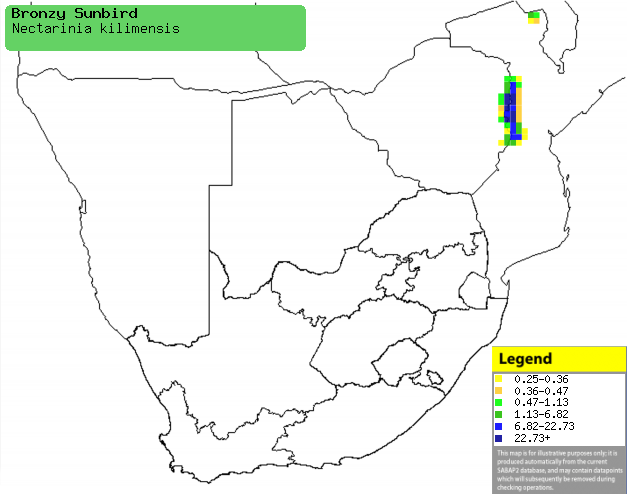|
Nectarinia kilimensis (Bronzy
sunbird, Bronze Sunbird)
Bronssuikerbekkie [Afrikaans]; Bronshoningzuiger [Dutch];
Souimanga bronzé [French]; Bronzenektarvogel [German]; Beija-flor-bronzeado
[Portuguese]
Life
> Eukaryotes >
Opisthokonta
> Metazoa (animals) >
Bilateria >
Deuterostomia > Chordata >
Craniata > Vertebrata (vertebrates) > Gnathostomata (jawed
vertebrates) > Teleostomi (teleost fish) > Osteichthyes (bony fish) > Class:
Sarcopterygii (lobe-finned
fish) > Stegocephalia (terrestrial
vertebrates) > Tetrapoda
(four-legged vertebrates) > Reptiliomorpha > Amniota >
Reptilia (reptiles) >
Romeriida > Diapsida > Archosauromorpha > Archosauria >
Dinosauria
(dinosaurs) > Saurischia > Theropoda (bipedal predatory dinosaurs) >
Coelurosauria > Maniraptora > Aves
(birds) > Order: Passeriformes
> Family: Nectariniidae
Distribution and habitat
Occurs in small patches from eastern DRC, Uganda and Kenya
through Tanzania and Malawi to southern Africa. Here it is uncommon to locally
common in Zimbabwe's eastern highlands and adjacent Mozambique, generally
preferring edges of Afromontane forest, mountainsides with dense scrub and
gardens.
|
 |
|
Distribution of Bronzy sunbird in southern Africa,
based on statistical smoothing of the records from first SA Bird Atlas
Project (©
Animal Demography unit, University of
Cape Town; smoothing by Birgit Erni and Francesca Little). Colours range
from dark blue (most common) through to yellow (least common). |
Predators and parasites
It has been recorded as host of the following parasites:
- Leucocytozoan nectariniae (sporozoan parasite)
- Ptilonyssus cinnyris (feather mite)
- microfilariae
Food
It eats nectar and arthropods, gleaning prey from
vegetation and hawking insects aerially, although it was once recorded to forage
in an occupied classroom! The following food items have been recorded
in its diet:
- Nectar
- Aloe
- Crotalaria (rattle-pods)
- Erythrina (coral-trees)
- Faurea rochetiana (Broad-leaved beechwood)
- Halleria lucida (Tree-fuchsia)
- Kigelia africana (Sausage-tree)
- Kniphofia (torch-lilies)
- Lobelia
- Protea
- Loranthaceae (mistletoes)
- Syzygium
- Leonotis (wild daggas)
- Tecoma capensis (Cape-honeysuckle)
- Fuchsia
- Arthropods
Breeding
- The nest is built solely by the female in about 5-15 days, consisting of a
oval-shaped structure built of ferns, bits of dry grass, shreds of bark,
bracken, leaves, lichen and inflorescences, secured with spider web. The
entrance is positioned on the side covered by a small flap, while the
interior is lined with fine grass inflorescences and plant down. It is
typically attached at the roof to a branch within a thicket, clump of bushes
or of a sapling, often on the border of Afromontane forest overlooking
marshy ground or a stream.
- Egg-laying season is from September-May, peaking from October-December.
- It lays 1-2 eggs, which are incubated solely by the female for about
13-15 days.
- The chicks are fed and brooded mainly by the female, leaving the nest
after about 16-21 days. As fledglings they continue to return to the nest
for about a week longer, becoming fully independent about 2-3 weeks later.
Threats
Not threatened, in fact it has benefited from the
introduction of Protea farming and gardens to Zimbabwe.
References
-
Hockey PAR, Dean WRJ and Ryan PG 2005. Roberts
- Birds of southern Africa, VIIth ed. The Trustees of the John Voelcker
Bird Book Fund, Cape Town.
|
